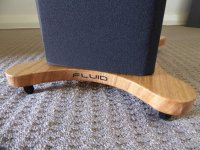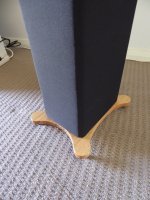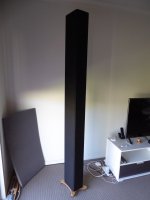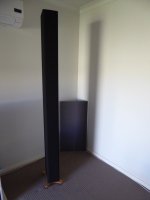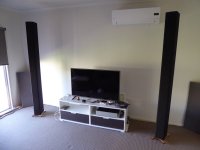The graph with the 24kHz ringing showed the waveform amplitude cresting and falling several times before fading away. This is representative of what happens when two tones with nearby frequencies are mixed, creating an amplitude pattern that rises and falls according to constructive and destructive interference.I'm a bit confused as to what you are referring to, the image you quoted is Byrtt's with a 192kHz sample rate, that makes it a little harder to compare to mine at 48K.
Moire patterns is a video term to describe one form of aliasing, there are no 44 to 48 conversions in the loopback tests so I am a bit confused as to what you mean.
In fact there is a musical instrument known as a theremin that uses the constructive and destructive interference between two RF waveforms at different frequencies to create a musical tone (absolute value sine wave) from the interference.
I have uploaded an audacity screenshot showing the result of adding a 2205Hz and 2400Hz waveform. The graph I referenced had evidence of two independent ringing frequencies which constructively and destructively combined resulting in the waveform. So the amplifier rang at two distinct frequencies which had roughly the same decay time, possibly a result of combining the left and right channels together.
I dunno really. The fact the ringing exists wholly in the ultrasonic domain means it shouldn't matter as far as listening is concerned.
Attachments
Last edited:
The graph with the 24kHz ringing showed the waveform amplitude cresting and falling several times before fading away. This is representative of what happens when two tones with nearby frequencies are mixed, creating an amplitude pattern that rises and falls according to constructive and destructive interference.
In fact there is a musical instrument known as a theremin that uses the constructive and destructive interference between two RF waveforms at different frequencies to create a musical tone (absolute value sine wave) from the interference.
I have uploaded an audacity screenshot showing the result of adding a 2205Hz and 2400Hz waveform. The graph I referenced had evidence of two independent ringing frequencies which constructively and destructively combined resulting in the waveform. So the amplifier rang at two distinct frequencies which had roughly the same decay time, possibly a result of combining the left and right channels together.
I think I see what you are saying. In Byrtt's graph at 192K it might look like that but the shape of the ringing is divided by the peak into pre and post ringing, the shape is only relevant if it appears either before or after not separated by the peak.
In my Scarlett graph and in Byrtt's UMC graph the post ringing does show that same pattern. Hard to say why that is as there was no sample rate conversion or mismatch involved.
Apart from curiosity to understand the process better a little bit of ultrasonic ringing shouldn't be a problem.I dunno really. The fact the ringing exists wholly in the ultrasonic domain means it shouldn't matter as far as listening is concerned.
OPC,
Here are the simulations of the cone displacements for a 2L rear chamber per driver, with 9V (parallel) and 45v (series) with stuffing in rear chamber.
SERIES:
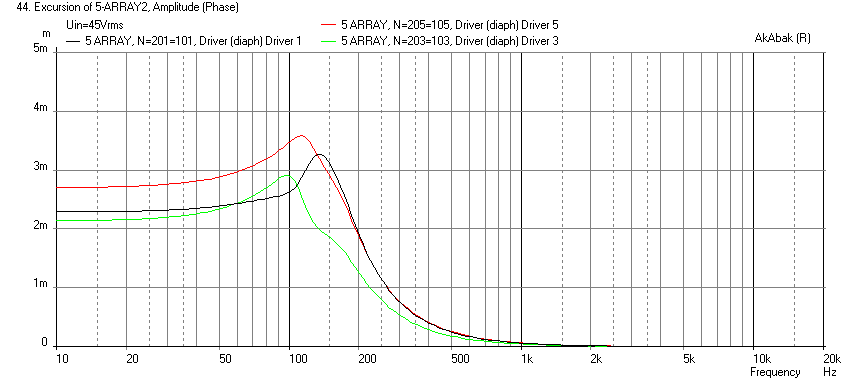
PARALLEL:
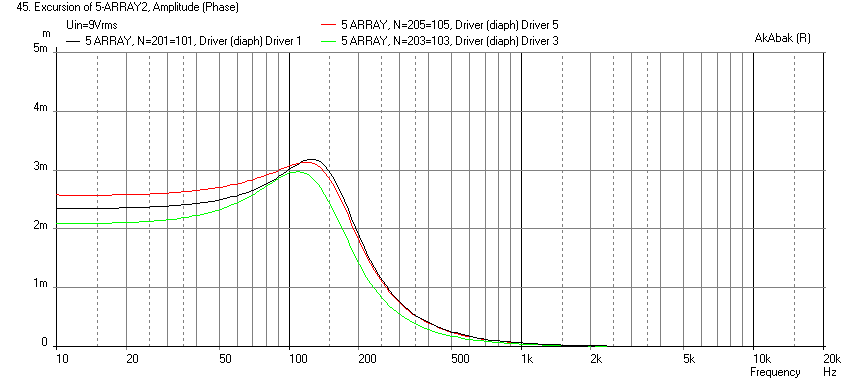
This is an intriguing result. It makes a strong argument for multiple low power amplifiers to drive two or three parallel connected drivers, or perhaps a 2s/2p at the most, in order to maintain better control the voice coils.
This is an intriguing result. It makes a strong argument for multiple low power amplifiers to drive two or three parallel connected drivers, or perhaps a 2s/2p at the most, in order to maintain better control the voice coils.
Hi susyj,
Yes, I never would have thought the differences would be so great until I ran the sim. It was Wesayso who urged me to run the sim. In reality, we probably won't hear much of this because the cones are flapping about in their linear range. It's when you start pushing power through them and some may be hitting xmax or beyond. There will be more distortion on the cones moving more of course. On a a line array with 25 drivers may be less noticeable than a single. But I the quality of the overall I integrated sound in distortion and phase space may not be consistent. Even if we can't easily hear the difference. It does say to choose parallel over series. And ideally a single amp for each set in series. Here is where 16ohm drivers like Faital Pro 3FE22 are handy.
Yes, I never would have thought the differences would be so great until I ran the sim. It was Wesayso who urged me to run the sim. In reality, we probably won't hear much of this because the cones are flapping about in their linear range. It's when you start pushing power through them and some may be hitting xmax or beyond. There will be more distortion on the cones moving more of course.
As this simulation of pure parallel vs series has the greatest variation around the Fs of the drivers it would be interesting to see if the conjugate impedance flattening circuit that wesayso uses reduces the variance, while a little more work to put the components in the simulation it could be a useful data point.
I have tried to take some better photos of the finished speakers in room.
I am very happy with how they look and are pretty much what I envisioned except I think that I underestimated the height in my mind!
Not the best pictures in the world but hopefully you get the idea. Big black rectangles are not that easy to photograph inside
I am going to be away for the next few weeks so in room measuring and listening won't be happening until I get back.
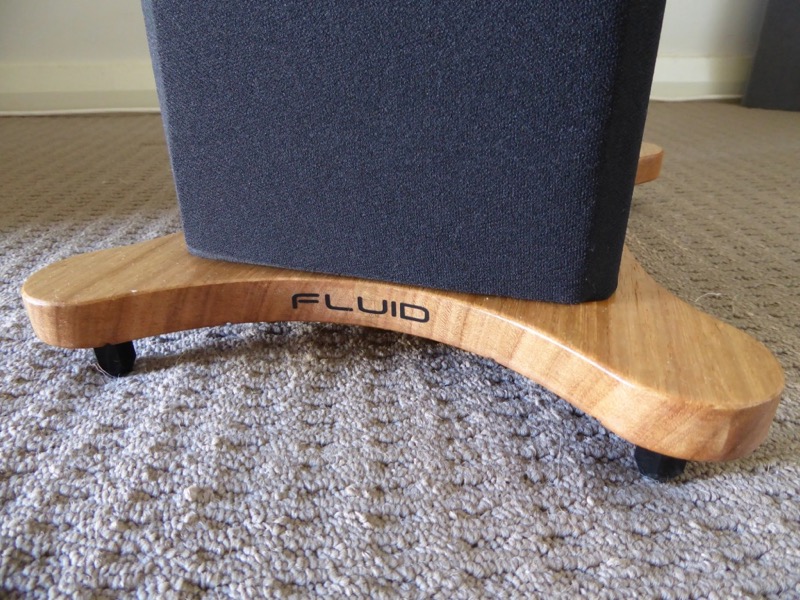
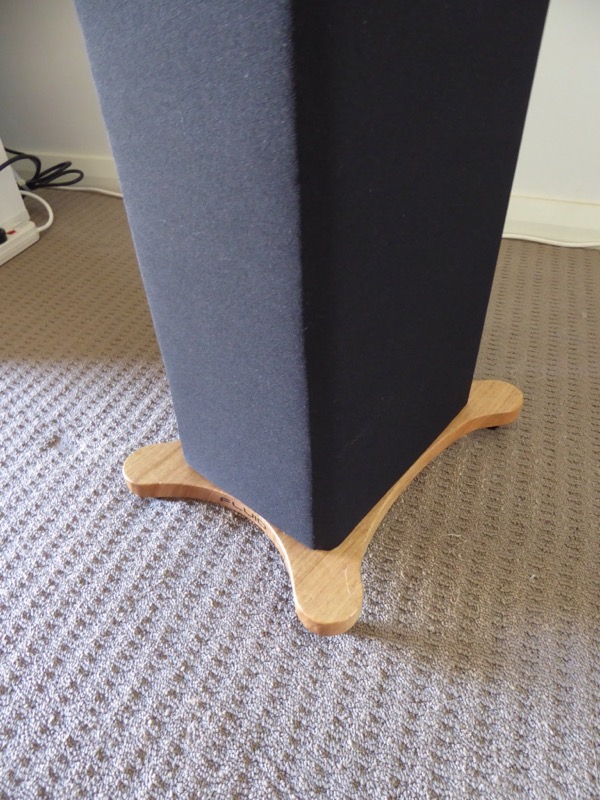
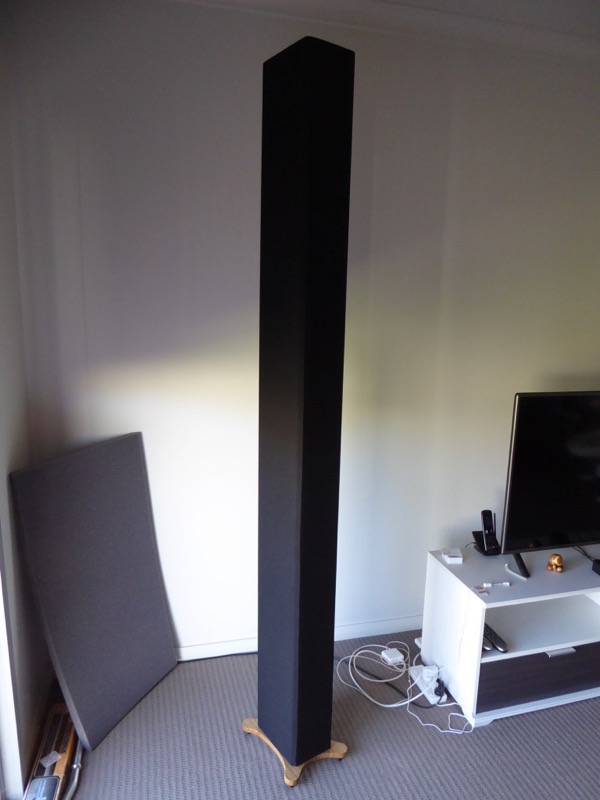
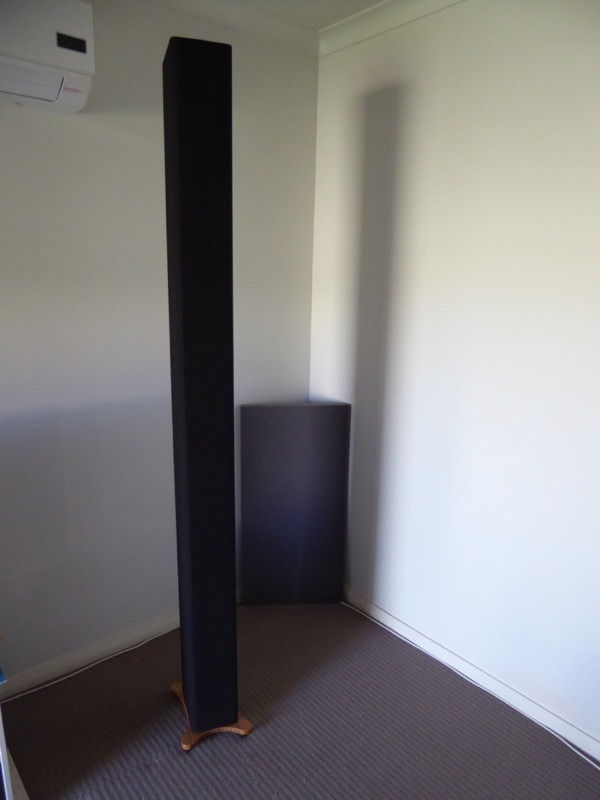
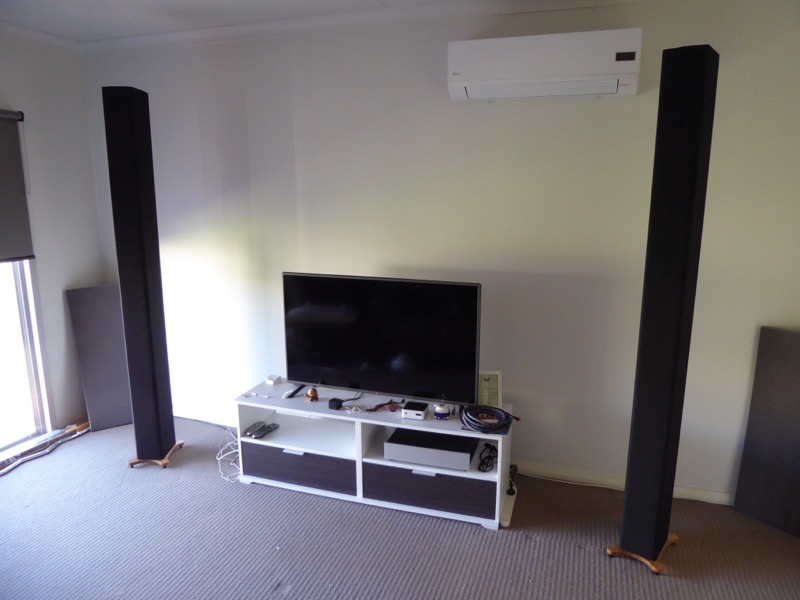
I am very happy with how they look and are pretty much what I envisioned except I think that I underestimated the height in my mind!
Not the best pictures in the world but hopefully you get the idea. Big black rectangles are not that easy to photograph inside
I am going to be away for the next few weeks so in room measuring and listening won't be happening until I get back.
Attachments
Hello Fluid,
Going away for a few weeks without leaving behind a listening impression of those 'big black rectangles'?!
Very nice build. Guessing these speakers would pull the 'disappearing act' to a spectacular feat as often attributed to such arrays and considering your matt black stealth finish, only feet are showing!
Hope its not too early to ask, are you planning on a sub or a super-tweeter?
And, what amplifier are you using, an UcD? Sorry, I missed that in the long thread.
Going away for a few weeks without leaving behind a listening impression of those 'big black rectangles'?!
Very nice build. Guessing these speakers would pull the 'disappearing act' to a spectacular feat as often attributed to such arrays and considering your matt black stealth finish, only feet are showing!
Hope its not too early to ask, are you planning on a sub or a super-tweeter?
And, what amplifier are you using, an UcD? Sorry, I missed that in the long thread.
Thanks for all the positive comments guys, I was starting to think I might have scared everyone off with the side discussions of ringing impulses and series/parallel wiring!
Samuel I am afraid so, the only listening I have done has been to one speaker in mono with rough EQ and I liked it. Hard to say anymore than that given the circumstances but I did listen to it like that for about an hour. If it was rubbish I would have stopped at one or two tracks
I don't plan on a sub or super tweeter. The point of these for me was to be able to get a full range music system in a small footprint so that they can fit easily in a living room.
I could be persuaded on the subs as there is no replacement for displacement but extra speakers wires and amps for them isn't what I want right now. I have the parts to build some synergy style horns and subs will be part of that system.
One of the great benefits of a tall line array like this is that vertical listening height is not really an issue, if you put a single tweeter in that goes away. I do not see any value in producing frequencies above 20kHz and the arrays get close enough for me in the measurements so far.
The amp I have been using is my 8 channel UcD one, only the two UcD400 modules are being used. I have built a First One M to power this system along with an ES9018 DAC. It remains to be seen if the amp has enough power at 160W (8 Ohms), it should be OK as Wesayso uses 100 watts. I need to do some measurements on that amp to confirm if I have the bias set correctly before I start listening to it seriously and I need to know how much voltage I get out of the DAC at different frequencies due to the EQ scheme.


I know I know It might sound silly but I really don't know how they sound other than that short test. I wanted to get them moved into position and concentrated on that. Now they are in the living room, setting up and listening is subject to family approval I'm afraid.
It might sound silly but I really don't know how they sound other than that short test. I wanted to get them moved into position and concentrated on that. Now they are in the living room, setting up and listening is subject to family approval I'm afraid.
I have made some EQ adjustments based on the outdoor measurements so when I get back I can test that to see if it has changed anything for the better.
Hello Fluid,
Going away for a few weeks without leaving behind a listening impression of those 'big black rectangles'?!
Very nice build. Guessing these speakers would pull the 'disappearing act' to a spectacular feat as often attributed to such arrays and considering your matt black stealth finish, only feet are showing!
Hope its not too early to ask, are you planning on a sub or a super-tweeter?
And, what amplifier are you using, an UcD? Sorry, I missed that in the long thread.
Samuel I am afraid so, the only listening I have done has been to one speaker in mono with rough EQ and I liked it. Hard to say anymore than that given the circumstances but I did listen to it like that for about an hour. If it was rubbish I would have stopped at one or two tracks
I don't plan on a sub or super tweeter. The point of these for me was to be able to get a full range music system in a small footprint so that they can fit easily in a living room.
I could be persuaded on the subs as there is no replacement for displacement but extra speakers wires and amps for them isn't what I want right now. I have the parts to build some synergy style horns and subs will be part of that system.
One of the great benefits of a tall line array like this is that vertical listening height is not really an issue, if you put a single tweeter in that goes away. I do not see any value in producing frequencies above 20kHz and the arrays get close enough for me in the measurements so far.
The amp I have been using is my 8 channel UcD one, only the two UcD400 modules are being used. I have built a First One M to power this system along with an ES9018 DAC. It remains to be seen if the amp has enough power at 160W (8 Ohms), it should be OK as Wesayso uses 100 watts. I need to do some measurements on that amp to confirm if I have the bias set correctly before I start listening to it seriously and I need to know how much voltage I get out of the DAC at different frequencies due to the EQ scheme.
ThanksWow, they really look great!
Thanks, me too but it will have to wait as I have run out of timeThey look really professional fluid. Very clean. Can't wait to hear what you think about the sound of the line array!
Typical... first you leave us waiting for months, dragging along the build while talking about everything except the arrays...
When they are finally finished, you skip town without telling us how you like em!
(just kidding, they do look beautiful!)
I know I know
I have made some EQ adjustments based on the outdoor measurements so when I get back I can test that to see if it has changed anything for the better.
You earned a well deserved rest I think. After which, you have something great to come back to and share with us.... I know, some of these more complicated projects can put a tax on one's sanity.
Fluid,
The speakers look really good, very professional. Well done mate and enjoy your holiday. Look forward to updates when you're back.
Very nice build Fluid. Super pro looking with a cloth grille. Are those base foot extensions strong enough to withstand the weight - I see grain going across area of max cantilever stress.
Have good holiday.
Thanks
I'm not worried about the wooden base, it would take quite some effort to weaken 19mm solid oak. The wooden base is two pieces joined through the centre with a glued tongue and groove joint. Each side has two 40mm x 6mm bolts with large heads that go through the wood and screw into insert nuts that are set in the bottom of the cabinet. Each spike is fitted into another insert nut that is screwed into the wood very tightly. The load is spread quite evenly so I can't see there being undue stress on the outside.
Wow, gorgeous build fluid! Nice work! The wood provides a nice contrast. Room looks a little bare though. Are you planning to build some kind of absorbers, etc... maybe you already have something.
X, thanks for the sims, again! While they do show a difference, I doubt any of us will ever apply 9V to each driver in a 25-driver array. I'm being lazy in not doing the math, but I'm pretty sure the output will reach ear-crushing levels much before the series wiring starts to become an issue. And even in this extreme case, there is still only 0.5 mm difference in max excursion.
Anyway, thanks to fluid for allowing us to sustain this discussion in his thread. Looks like if you are wiring subs, where you might need outrageous amounts of power and where high levels of excursion is common, it is better not wire them all in series. Lesson learned, and a good little excursion this was (if you don't mind the pun!).
X, thanks for the sims, again! While they do show a difference, I doubt any of us will ever apply 9V to each driver in a 25-driver array. I'm being lazy in not doing the math, but I'm pretty sure the output will reach ear-crushing levels much before the series wiring starts to become an issue. And even in this extreme case, there is still only 0.5 mm difference in max excursion.
Anyway, thanks to fluid for allowing us to sustain this discussion in his thread. Looks like if you are wiring subs, where you might need outrageous amounts of power and where high levels of excursion is common, it is better not wire them all in series. Lesson learned, and a good little excursion this was (if you don't mind the pun!).
I believe the comment from Owen about wiring subs in series applied to the subwoofer drivers being in a common box and yes, at very high levels. I don't think? drivers would tear themselves apart if they were wired in series in separate enclosures? Can anyone give a heads up on this? I'm building subs with 4 8" drivers per side....Anyway, thanks to fluid for allowing us to sustain this discussion in his thread. Looks like if you are wiring subs, where you might need outrageous amounts of power and where high levels of excursion is common, it is better not wire them all in series. Lesson learned, and a good little excursion this was (if you don't mind the pun!).
Wow, gorgeous build fluid! Nice work! The wood provides a nice contrast. Room looks a little bare though. Are you planning to build some kind of absorbers, etc... maybe you already have something.
X, thanks for the sims, again! While they do show a difference, I doubt any of us will ever apply 9V to each driver in a 25-driver array. I'm being lazy in not doing the math, but I'm pretty sure the output will reach ear-crushing levels much before the series wiring starts to become an issue. And even in this extreme case, there is still only 0.5 mm difference in max excursion.
Anyway, thanks to fluid for allowing us to sustain this discussion in his thread. Looks like if you are wiring subs, where you might need outrageous amounts of power and where high levels of excursion is common, it is better not wire them all in series. Lesson learned, and a good little excursion this was (if you don't mind the pun!).
Thanks
You are right the room doesn't have many absorptive surfaces. This is a rented house which will not be the arrays forever home and it is also a living room so there is not much likelihood of large damping panels and bass traps appearing. I have considered making a damping poster like wesayso did to put behind the listening position as that could be used anywhere in the future. I am hopeful that the arrays will be pleasant enough in this room but I am under no illusions that it will not be as good as them being in a treated room. I think it's important to consider how they perform without treatment as the vast majority of listening spaces have no room treatment.
Voltage is not spread between the drivers, power is. Assuming an 8 ohm load 9V into 8 Ohms is only 10 watts total, 100w into the array would be 28V. I think it would take a bit more than 10 watts to get ear splitting loud. The 9 volt vs 45 was to make power dissipation equal between 5 series to 5 parallel connections due to the load changing in the wiring schemes.
I believe the comment from Owen about wiring subs in series applied to the subwoofer drivers being in a common box and yes, at very high levels. I don't think? drivers would tear themselves apart if they were wired in series in separate enclosures? Can anyone give a heads up on this? I'm building subs with 4 8" drivers per side.
Bushmeister posted this information in Post #436 taken from JL Audio which describes the phenomenon quite well
Hi guys - regarding the series/parallel issue - thought I would share a bit of information that may or may not be relevant when looking into the wiring of my planned subwoofers:
This was taken from JL Audio's website (apologies if you have already seen this):
It is far less desirable to make subwoofer to subwoofer connections in series. Due to slight and unavoidable differences between speakers and the high likelihood of uneven loading between different speakers in a car, there will be slight differences in the mechanical behavior of the two speakers in series. These differences in movement result in the creation of induced voltage (called back EMF) by the speakers across the series connection. This effect causes a problem when two speakers that behave differently are connected in series because the speakers can modulate each other (cause each other to move), resulting in distortion. The problem becomes more serious as more speakers are connected in series.
The following is a good experiment to show the effect of back EMF: connect four speakers in series and short the positive and negative input leads of the series circuit. Push down on one cone with your hand; you will notice that the three other speakers will move in the opposite direction of the one you are pushing. Now, reconnect the speakers in parallel, short the inputs and push down on one cone. The speakers will not modulate each other because each one is shorted directly.
If you can avoid wiring subs in series then do so as you don't need to worry about what if's then. Having them in separate enclosures is better than in the same, less drivers in series is better than more. 4 in series parallel in the same enclosure should be OK but if you haven't built the enclosure yet then it would make sense to keep the series drivers in separate enclosures which would only require a central divider to separate them. (I think you have 4 ohm drivers so series parallel is probably your best choice to avoid too low of an impedance).
For it to be damaged you would need quite a few in series in the same enclosure with a lot of power.
I have tested my series parallel arrangement and if the inputs are shorted there is no cone movement in other drivers from moving one driver like in a pure series arrangement.
I honestly believe for woofers to get damaged, you need more than two, series connected, in a smallish sealed container. It's like a tug of war game but with 5 drivers working in tandem. If a driver gets out of phase for any reason, three or four or five drivers working against it will rip it to shreds.If you can avoid wiring subs in series then do so as you don't need to worry about what if's then. Having them in separate enclosures is better than in the same, less drivers in series is better than more. 4 in series parallel in the same enclosure should be OK but if you haven't built the enclosure yet then it would make sense to keep the series drivers in separate enclosures which would only require a central divider to separate them. (I think you have 4 ohm drivers so series parallel is probably your best choice to avoid too low of an impedance).
For it to be damaged you would need quite a few in series in the same enclosure with a lot of power.
I have tested my series parallel arrangement and if the inputs are shorted there is no cone movement in other drivers from moving one driver like in a pure series arrangement.
This damage scenario would be impossible if each driver had it's own sealed enclosure because I strongly believe the backwave pressure from three or more drivers loaded very close to xmech would easily overpower and catastrophically blow the remaining cone. Series is tug of war with a single large load and everyone sharing the same rope. Parallel is tug of war with everyone pulling a separate rope connected to a single large load. And a sealed off enclosure for every driver in either configuration would be like five horses pulling five small carts, each isolated from the others.
I honestly believe for woofers to get damaged, you need more than two, series connected, in a smallish sealed container. It's like a tug of war game but with 5 drivers working in tandem. If a driver gets out of phase for any reason, three or four or five drivers working against it will rip it to shreds.
This damage scenario would be impossible if each driver had it's own sealed enclosure because I strongly believe the backwave pressure from three or more drivers loaded very close to xmech would easily overpower and catastrophically blow the remaining cone. Series is tug of war with a single large load and everyone sharing the same rope. Parallel is tug of war with everyone pulling a separate rope connected to a single large load. And a sealed off enclosure for every driver in either configuration would be like five horses pulling five small carts, each isolated from the others.
You must be looking at different graphs than me...

At least your analogy does not work for me.
- Home
- Loudspeakers
- Full Range
- Full Range TC9 Line Array CNC Cabinet

